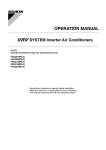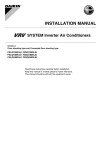Download Daikin FXAQ-PVJU Installation manual
Transcript
00_CV_3PN07520-6E.fm Page 1 Friday, December 2, 2011 11:05 AM OPERATION MANUAL SYSTEM Inverter Air Conditioners MODELS Wall-mounted type FXAQ07PVJU FXAQ09PVJU FXAQ12PVJU FXAQ18PVJU FXAQ24PVJU English Français Español Read these instructions carefully before installation. Keep this manual in a handy place for future reference. This manual should be left with the equipment owner. Lire soigneusement ces instructions avant l’installation. Conserver ce manuel à portée de main pour référence ultérieure. Ce manuel doit être donné au propriétaire de l’équipement. Lea cuidadosamente estas instrucciones antes de instalar. Guarde este manual en un lugar a mano para leer en caso de tener alguna duda. Este manual debe permanecer con el propietario del equipo. 01_EN_3PN07520-6E.fm Page 1 Thursday, December 8, 2011 5:11 PM SAFETY CONSIDERATIONS Read these Safety Considerations for Operations carefully before installing air conditioning equipment. After completing the installation, make sure that the unit operates properly during the startup operation. Instruct the customer on how to operate and maintain the unit. Inform customers that they should store this Operation Manual with the Installation Manual for future reference. Meanings of DANGER, WARNING, CAUTION, and NOTE Symbols: DANGER ............ Indicates an imminently hazardous situation which, if not avoided, will result in death or serious injury. WARNING .......... Indicates a potentially hazardous situation which, if not avoided, could result in death or serious injury. CAUTION............ Indicates a potentially hazardous situation which, if not avoided, may result in minor or moderate injury. It may also be used to alert against unsafe practices. NOTE.................. Indicates situations that may result in equipment or property-damage accidents only. DANGER WARNING • Contact your dealer for repair and maintenance. Improper repair and maintenance may result in water leakage, electric shock, and fire. Only use accessories made by Daikin that are specifically designed for use with the equipment and have them installed by a professional. • Contact your dealer to move and reinstall the air conditioner. Incomplete installation may result in water leakage, electric shock, and fire. • Never let the indoor unit or the remote controller get wet. Water can cause an electric shock or a fire. • Never use flammable spray such as hair spray, lacquer, or paint near the unit. Flammable spray may cause a fire. • When a fuse blows out, never replace it with one of incorrect ampere ratings or different wires. Always replace any blown fuse with a fuse of the same specification. • Never remove the fan guard of the unit. A fan rotating at high speed without the fan guard is very dangerous. • Never inspect or service the unit by yourself. Contact a qualified service person to perform this work. • Turn off all electrical power before doing any maintenance to avoid the risk of serious electric shock; never sprinkle or spill water or liquids on the unit. • Do not install the unit in an area where flammable materials are present due to risk of explosion resulting in serious injury or death. • Do not touch the switch with wet fingers. Touching a switch with wet fingers can cause electric shock. • Any abnormalities in the operation of the air conditioner such as smoke or fire could result in severe injury or death. Turn off the power and contact your dealer immediately. • Do not allow children to play on or around the unit to prevent injury. • Refrigerant gas may produce toxic gas if it come in contact with fire, such as from a fan, heater, stove, or cooking device. Exposure to this gas could cause severe injury or death. • For refrigerant leakage, consult your dealer. Refrigerant gas is heavier than air and replaces oxygen. A massive leak could lead to oxygen depletion, especially in basements, and an asphyxiation hazard could occur leading to serious injury or death. • If equipment utilizing a burner is used in the same room as the air conditioner, there is the danger of oxygen deficiency which could lead to an asphyxiation hazard resulting in serious injury or death. Be sure to ventilate the room sufficiently to avoid this hazard. • Safely dispose of the packing materials. Packing materials, such as nails and other metal or wooden parts, may cause stabs or other injuries. • Tear apart and throw away plastic packaging bags so that children will not play with them. Children playing with plastic bags face the danger of death by suffocation. • The heat exchanger fins are sharp enough to cut. To avoid injury wear gloves or cover the fins while working around them. • Do not put a finger or other objects into the air inlet or air outlet. The fan is rotating at high speed and will cause injury. • Check the unit foundation for damage on a continuous basis, especially if it has been in use for a long time. If left in a damaged condition the unit may fall and cause injury. • Placing a flower vase or other containers with water or other liquids on the unit could cause a shock or fire if a spill occurs. • Do not touch the air outlet or horizontal blades while the swing flap is in operation because fingers could get caught and injured. • Never touch the internal parts of the controller. Do not remove the front panel because some parts inside are dangerous to touch. To check and adjust internal parts, contact your dealer. • Be sure to establish a ground. Do not ground the unit to a utility pipe, arrester, or telephone ground. Incomplete grounding may cause electrical shock, or fire. A high surge current from lightning or other sources may cause damage to the air conditioner. • Be sure to install a ground fault circuit interrupter. Failure to install a ground fault circuit interrupter may result in electric shocks, or fire. 1 English 01_EN_3PN07520-6E.fm Page 2 Thursday, December 8, 2011 5:11 PM CAUTION • Do not use the air conditioner for any other purposes other than comfort cooling or heating. Do not use the unit for cooling precision instruments, food, plants, animals or works of art. • Do not place items under the indoor unit as they may be damaged by condensates that may form if the humidity is above 80% or if the drain outlet gets blocked. • Before cleaning, stop the operation of the unit by turning the power off or by pulling the supply cord out from its receptacle. Otherwise, an electric shock and injury may result. • Do not wash the air conditioner with excessive water. An electric shock or fire may result. • Avoid placing the controller in a spot splashed with water. Water entering the controller may cause an electric shock or damage the internal electronic parts. • Do not operate the air conditioner when using a room fumigation type of insecticide. Failure to observe this could cause the chemicals to be deposited in the unit and can endanger the health of those who are hypersensitive to chemicals. • Do not turn off the power immediately after stopping operation. Always wait for at least five minutes before turning off the power. Otherwise, water leakage may occur. • The appliance is not intended for use by young children or infirm persons without supervision. • The remote controller should be kept away from children so they cannot play with it. • Consult with the installation contractor for cleaning. • Incorrect cleaning of the inside of the air conditioner could make the plastics parts break and cause water leakage or electric shock. • Do not touch the air inlet or aluminum fin of the air conditioner as they can cut and cause injury. • Do not place objects in direct proximity of the outdoor unit. Do not let leaves and other debris accumulate around the unit. Leaves are a hotbed for small animals which can enter the unit. Once inside the unit, animals can cause the unit to malfunction, and cause smoke or fire when they make contact with electrical parts. NOTE • Never press the button of the remote controller with a hard, pointed object. The remote controller may be damaged. • Never pull or twist the electric wire of the remote controller. It may cause the unit to malfunction. • Do not place appliances that produce open flames in places that are exposed to the airflow of the unit or under the indoor unit. It may cause incomplete combustion or deformation of the unit due to the heat. English • Do not expose the controller to direct sunlight. The LCD display can become discolored and may fail to display the data. • Do not wipe the controller operation panel with benzene, thinner, chemical dust cloth, etc. The panel may get discolored or the coating can peel off. If it is heavily dirty, soak a cloth in water-diluted neutral detergent, squeeze it well and wipe the panel clean. Then wipe it with another dry cloth. • Dismantling of the unit, disposal of the refrigerant, oil, and additional parts, should be done in accordance with the relevant local, state, and national regulations. • Operate the air conditioner in a sufficiently ventilated area and not surrounded by obstacles. Do not use the air conditioner in the following places. a. Places with a mist of mineral oil, such as cutting oil. b. Locations such as coastal areas where there is a lot of salt in the air. c. Locations such as hot springs where there is a lot of sulfur in the air. d. Locations such as factories where the power voltage varies a lot. e. In cars, boats, and other vehicles. f. Locations such as kitchens where oil may splatter or where there is steam in the air. g. Locations where equipment produces electromagnetic waves. h. Places with an acid or alkaline mist. i. Places where fallen leaves can accumulate or where weeds can grow. • Take snow protection measures. Contact your dealer for the details of snow protection measures, such as the use of a snow protection hood. • Do not attempt to do electrical work or grounding work unless you are licensed to do so. Consult with your dealer for electrical work and grounding work. • Pay Attention to Operating Sound. Be sure to use the following places: a. Places that can sufficiently withstand the weight of the air conditioner yet can suppress the operating sound and vibration of the air conditioner. b. Places where warm air from the air outlet of the outdoor unit or the operating sound of the outdoor unit does not annoy neighbors. • Make sure that there are no obstacles close to the outdoor unit. Obstacles close to the outdoor unit may drop the performance of the outdoor unit or increase the operating sound of the outdoor unit. • Consult your dealer if the air conditioner in operation generates unusual noise. • Make sure that the drainpipe is installed properly to drain water. If no water is discharged from the drainpipe while the air conditioner is in the cooling mode, the drainpipe may be clogged with dust or dirt and water leakage from the indoor unit may occur. Stop operating the air conditioner and contact your dealer. 2 01_EN_3PN07520-6E.fm Page 3 Thursday, December 8, 2011 5:11 PM Air inlet (front and top of main unit) Packaging materials If any packaging materials are included, please remove before operating. Air filter (Inside intake vent) Name plate (Indoor unit model name) Refrigerant pipe Transmission wiring Drain pipe Remote controller Air outlet Ground wire Conducts electricity from the unit into the ground to prevent electric shock. Louver (horizontal air outlet direction adjustment flaps) Vertical flaps (vertical air outlet direction adjustment flaps) Power supply wiring HOW TO ADJUST THE HORIZONTAL FAN DIRECTION ANGLE Hold the tabs on edge louvers (horizontal air outlet direction adjustment flaps) down slightly and adjust left and right to match the room conditions or your preference. MAINTENANCE (FOR SERVICE PERSONNEL) NOTE • Do not remove the air filter except when cleaning. This may cause breakage. HOW TO CLEAN THE AIR FILTER Clean the air filter when the display shows “TIME TO CLEAN FILTER”. • It will display that it will operate for a set amount of time. • Increase the frequency of cleaning if the unit is installed in a room where the air is extremely contaminated. • If the dirt becomes impossible to clean, change the air filter (Air filter for exchange is optional) Stop the vertical flaps at a position where you can hold the tabs and adjust the louver left and right. 3 1. Open the front panel. Place your fingers on the panel protrusions on the left and right sides of the main unit and open until the panel stops. (Follow the same procedure for closing.) English 01_EN_3PN07520-6E.fm Page 4 Thursday, December 8, 2011 5:11 PM 2. Pullout the air filter. Push up the tab in the center of the air filter slightly then pull out in a downward direction. • Do not let the indoor unit get wet. It may cause an electric shock or a fire. • Do not scrub firmly when washing the blade with water. The surface sealing may peel off. • Do not use water or air of 120°F or higher for cleaning air filters and outside panels. • Make sure the front panel is solidly in place. 1. Open the front panel. Place your fingers on the panel protrusions on the left and right sides of the main unit and open until the panel stops. (Follow the same procedure for closing.) 3. Clean the air filter. Use vacuum cleaner A) or wash the air filter with water B). A) Using a vacuum cleaner B) Washing with water When the air filter is very dirty, use soft brush and neutral detergent 2. Remove the front panel. Push the axes on either side of the front panel towards the center of the main unit and remove. (You can also remove it by sliding the front panel either to the left or right and pulling it forward.) Remove water and dry in the shade. NOTE • Do not wash the air filter with hot water of more than 120°F, as doing so may result in discoloration and/or deformation. • Do not expose it to fire, as doing so may result in burning. 4. Attach the air filter. Once cleaning is done be sure to replace the air filter as it was. 5. Shut the front panel. Refer to item No.1. 6. Press the FILTER SIGN RESET button on the remote controller. The “TIME TO CLEAN FILTER” display vanishes. HOW TO CLEAN THE AIR OUTLET AND EXTERIOR • Clean with soft cloth. • When it is difficult to remove stains, use water or neutral detergent. 3. Clean the front panel. • Wipe gently with a soft wet cloth. • Only use neutral cleaning agents. • After washing off, wipe off any excess water and dry in a shaded location. • When very grimy Directly apply the type of detergent used for cleaning ventilation fans or ovens, wait 10 minutes, and then rinse with water. NOTE • Do not wash the air conditioner with hot water of more than 120°F. Doing so may result in discoloration or deformation. NOTE • Do not use gasoline, benzene, thinner, polishing powder, liquid insecticide. It may cause discoloring or warping. • Do not use water or air of 120°F or higher for cleaning air filters. • When the flap is extremely contaminated, remove it as below and clean or exchange it. (Flap for exchange is optional.) 4. Attach the front panel. Set the keys of the front panel into the slots and push them in all the way. Close the front panel slowly in this state. HOW TO CLEAN THE FRONT PANEL You can remove the front panel to clean it. NOTE • Hold the front panel firmly so that it does not fall. • Do not use gasoline, benzene, thinner, polishing powder, liquid insecticide. It may cause discoloring or warping. English 4 00_CV_3PN07520-6E.fm Page 2 Friday, December 2, 2011 11:05 AM 1645 Wallace Drive, Suite 110 Carrollton, TX 75006 USA [email protected] www.daikinac.com 3PN07520-6E EM11A076 (1112) HT







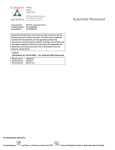
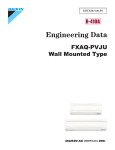
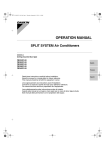
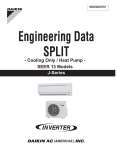
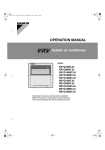
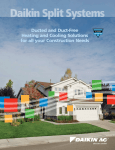
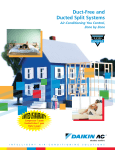
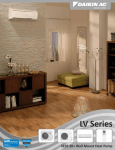

![Daikin - [Klima], aire acondicionado](http://vs1.manualzilla.com/store/data/005774952_1-8d861f394f8ece21c166c1fcfde6f130-150x150.png)
